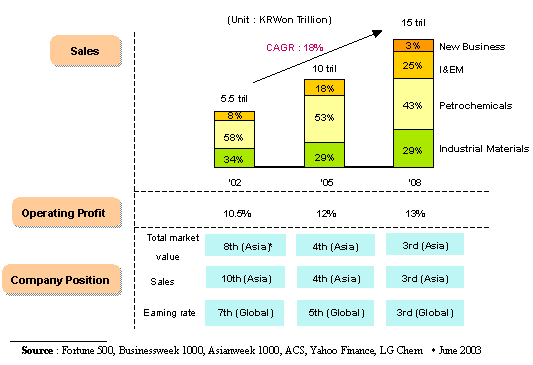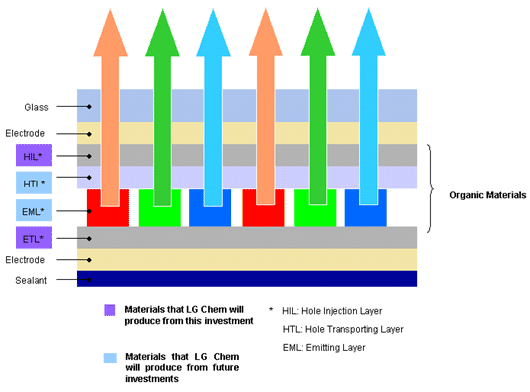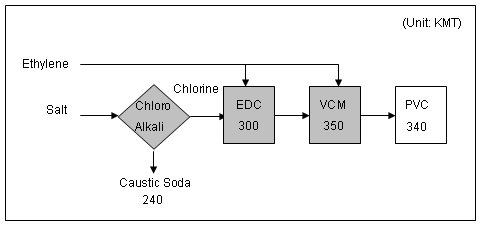ü@ü@ü@ü@ü@
2003.07.02 LG
Chem
LG Chem signs a
deal with Nanjing, China to establish a polarizer plant
LG Chem, Ltd., the largest chemical company in Korea, announced
today that LG Chem is setting up a local subsidiary to produce
TFT-LCDüithin-film-transistor
liquid-crystal-displaysüj polarizers in Nanjing,
China. The signing ceremony between LG Chem and Nanjing City took
place today. (TFTētÅ╗āfāBāXāvāīāCŚpĢ╬ī§ātāBāŗāĆ
inü@ōņŗ×)
A polarizer is a multi-layered optical film used for transmitting
light in TFT-LCD modules, which is mainly used in notebook PCs,
PC monitors, televisions, etc. To produce TFT-LCD polarizers
requires high technology, which, currently, only three Japanese
companies and LG Chem possess.
According to the investment contract with Nanjing City, LG Chem
will invest a total of USD 15 million until 2004 to establish a
polarizer plant with a capacity of 4 million ću. (14 million sets) Moreover, LG Chem is
planning to further its investment in China by building another
polarizer plant in China by 2006.
"The TFT-LCD polarizer market in China is growing fast as
global LCD companies are entering China to benefit from its rapid
growth in demand. Moreover, Chinese polarizer companies are also
growing in number. Thus, LG Chem has had to move up its schedule
for a TFT-LCD polarizer plant in China in order to solidify its
foothold in such an environment," said Jong-Pal Kim, the
Executive Vice President of LG Chem and Chief of LG Chem's
I&EM business.
The size of the Chinese TFT-LCD polarizer market is approximately
KRWon 30 billion. However, with the global display makers
advancing into China, plus the emergence of Chinese household
electric companies, the market is expected to grow ten-fold to a
size of KRWon 300 billion by 2006.
"With the establishment of a polarizer plant in China, LG
Chem will be able to conduct active marketing to its customers in
China and, therefore, secure half of the Chinese market. This
will enable the company to position itself as the leading
polarizer producer in China," Kim added.
LG Chem, the only TFT-LCD polarizer producer in Korea, currently
has a capacity of 3.8 million ću. The company has plans to
increase this capacity to 26 million ću
by 2006,
which will enable LG Chem to become the world No.1 producer by
securing a 35% global market share.
OVERVIEW OF LG CHEM
LG Chem, Ltd., is the leading chemical company in Korea in terms
of both size and performance. It is a vertically integrated
chemical company that manufactures a wide range of products from
petrochemical goods to high-value added plastics, floorings and
automotive parts. It also expands its chemical expertise to
high-tech materials for electronics and information technology
such as state-of-the-art rechargeable batteries and display
materials.
With annual sales of KRW 5.4 trillion (Yr 2002) and a global
workforce of approximately 10,000 employees, LG Chem plans to
realize positive progress towards sustainable growth by
consolidating its leadership in the domestic market and building
leader businesses outside of Korea.
Outline of the new Chinese subsidiary
LG Chem (Nanjing) Information & Electronic Materials
Co., Ltd.
| Location |
ü@ |
Nanjing
City, China (Economic Development Zone) |
| Ownership |
ü@ |
LG Chem
100% |
| Investment
|
ü@ |
USD 15
million |
| CAPA |
ü@ |
4
million ću (14 million sets) |
| Capital |
ü@ |
USD 5
million (KRWon 6 billion) |
Global Polarizer
Market
Global Polarizer Market sizeü@(Unit : KRWon 100 Million)
| ü@ |
ü@ü@ü@'02 |
ü@ü@ü@'03 |
ü@ü@ü@'04 |
ü@ü@ü@'06 |
Korea
|
3,800
|
4,500
|
4,600
|
5,100
|
China
|
-
|
300
|
1,100
|
3,000
|
Taiwan
|
3,200
|
3,800
|
4,500
|
5,500
|
Japan
|
2,400
|
2,100
|
2,200
|
2,100
|
Global
|
9,400
|
10,700
|
12,400
|
15,700
|
Chinese Polarizer Market sizeü@(Unit : KRWon 100 Million)
| ü@ |
ü@ü@ü@'02 |
ü@ü@ü@'03 |
ü@ü@'04 |
ü@ü@'05 |
Chinese Market
|
300
|
1,100
|
2,089
|
3,000
|
LG Chem's M/S
|
8%
|
36%
|
38%
|
50%
|
* Source :
DisplaySearch ('03. 1Q), LG Chem
2003/8/7ü@LG Chem
LG Chem aims KRWon 15 trillion in sales for 2008
LG Chem, Ltd., the largest chemical company in Korea, announced
today its new mid-to-long term business strategies and its goals
of KRWon 15 trillion in sales and a 13% operating profit rate for
2008.
LG Chem's ambitious mid-to-long term strategy concentrates on
strengthening its vertically integrated business structure. For
its petrochemical and industrial materials business, LG Chem has
plans to consolidate its foothold and position itself as a major
player in main growing markets such as China and the U.S. by
raising its product quality and cost competitiveness through
enhanced R&D and marketing abilities.
For its Information & Electronic Materials business, LG
Chem's core future business, the company plans to focus on rapid
developments of new high-tech products and increasing capacities
for its main products such as rechargeable batteries and display
materials.
Furthermore, LG Chem will enter new high value-added business
areas by applying IT technologies to its existing businesses. The
I&EM business and the new business areas is expected to
account for 28% of the company's total business portion by 2008.
Currently, the I&EM business takes up 8% of total business.
"With the successful completion of the acquisition of
Hyundai Petrochemical and the rapid growth in the Information
& Electronic Materials business, we have also raised our
mid-term goals, to reach KRWon 10 trillion in sales and a 12%
operating profit rate for 2005," said Ki Ho No, the
president and CEO of LG Chem.
After its successful spin-off, which took place in 2001, LG Chem
had earlier set a mid-term goal of KRWon 8 trillion in sales and
KRWon 800 billion in recurring profit.
"By 2008, LG Chem will become the 3rd largest chemical
company in the world in terms of earning rates and the 3rd
largest in Asia in terms of the sales amount and stock
value," No added.
In line with its mid-to-long term strategy, LG Chem has
prioritized six products among its wide range of products, which
have high possibilities of obtaining a leading position in the
world. The six products are ABS (Acrylonitrile Butadiene Styrene), PVC (Polyvinyle Chloride), HI-MACS (Artificial
Marble), surface materials such as
High Gloss Sheets, polarizers, and rechargeable batteries.
"LG Chem will increase its R&D resources to enhance its
competitiveness by providing innovative products and total
solutions to its customers and will also strive to become a truly
globalized chemical company," said the CEO.
Editor's Note
OVERVIEW OF LG CHEM
LG Chem, Ltd., is the leading chemical company in Korea in terms
of both size and performance. It is a vertically integrated
chemical company that manufactures a wide range of products from
petrochemical goods to high-value added plastics, floorings and
automotive parts. It also expands its chemical expertise to
high-tech materials for electronics and information technology
such as state-of-the-art rechargeable batteries and display
materials.
With annual sales of KRW 5.4 trillion (Yr 2002) and a global
workforce of approximately 10,000 employees, LG Chem plans to
realize positive progress towards sustainable growth by
consolidating its leadership in the domestic market and building
leader businesses outside of Korea.
LG Chem's Mid-to-Long Term Goal

2003-8-7 Asia Chemical Weekly
LG Chem to expand Yeochun styrene to 500 kt/yr
LG Chem plans to expand its 375
000 tonne/year styrene plant in Yeochun, South Korea, to 500 000
tonne/year later this year, the company said.
The major currently buys more than 200 000 tonne/year of styrene
and the extra styrene would help LG reduce its styrene purchases
before it expands its acrylonitrile butadiene styrene (ABS)
capacity.
LG plans to boost its ABS capacity to 500 000 tonne/year from 300
000 tonne/year by 2005 in Ningbo, Zhejiang, China.
LG's reliance on styrene purchases would also be reduced after
Hyundai Petrochemical's assets, including two styrene plants, are
split between LG and Honam Petrochemical.
LG Chem and Honam formed a consortium which successfully acquired
Hyundai's petrochemical assets for Won1.74trn
($1.47bn/Euro1.30bn) earlier this year.
Æ®æNō·Ģ±ü@2003.08.28
ékéfüAé`éaérüEāfāWā^āŗāeāīāréÅWÆåłńɼéų
ü@ékéfé═éQéWō·üAāvāēāXā`ābāNé╠łĻÄĒé┼éĀéķŹéĢtē┴ŹćɼĄÄēé`éaérüiékéfē╗ŖwüjéŲāfāWā^āŗāeāīārüiékéfōdÄqüjüAāeāīātāHāōāVāćābāsāōāOüiékéfāzü[āĆāVāćābāsāōāOüjéüuéPōÖÉĒŚ¬ÄYŗŲüvé╔æIÆĶüAéQéOéOéTöNé▄é┼éQÆøāEāHāōéōŖéČüAÅWÆåłńɼéĘéķé▒éŲé╔éĄéĮüB
ü@ékéfé═é`éaéréŲāfāWā^āŗāeāīāré¬éQéOéOéTöNé╔ÉóŖEāgābāvéÆBɼéĄüAāeāīātāHāōāVāćābāsāōāOé═ŹæōÓāgābāvéī┼é▀éĮīŃé╔ÉóŖEÄsÅĻé╔ÉiÅoéĘéķĢ¹ÉjéŠüB
ü@ékéfé═éQéWō·üAŗ×ŗEüiāLāćāōāMüjō╣üEŚśÉņüiāCā`āćāōüjé╠ékéfÉmśaüiāCāōātā@üjē@é┼üAŗ’¢{¢╬üiāNüEā{āōāĆüjē’ÆĘé╚éŪüAāOāŗü[āvīnŚ±é╠Ź┼ŹéīoēcÄęüiébédénüjéTéOŚ]Élé¬ÅoÉ╚éĄéĮÆåüAüuāOāŹü[āoāŗébédénÉĒŚ¬ē’ŗcüvéŹséóüAé▒éĻéńéRĢ¬¢ņé╠éPōÖÆBɼé╔ī³é»éĮÉĒŚ¬éśb饏ćé┴éĮüB
ü@ékéfé╠ōAæŖŹæüiā`āćāōüEāTāōāOāNüjĢøÄąÆĘé═üuāOāŹü[āoāŗébédénÉĒŚ¬ē’ŗcé═ékéfāOāŗü[āvé╠Ź┼ŹéÉĒŚ¬ē’ŗcé┼üAĤÉóæŃɼÆĘÄYŗŲéŲ¢óŚłéPōÖÄ¢ŗŲé╠ŗ’æ╠ōIé╚łńɼł─éŗ”ŗcéĘéķéÓé╠üvéŲÉÓ¢ŠéĄéĮüB
ü@ékéfé═é▄éĖüAæõśpāüü[āJü[éŲāgābāvæłéóéēēéČéķé`éaérÄ¢ŗŲé═ÆåŹæÄsÅĻé┼é╠ŤĢēéæ_éóüAÆåŹæōÓé╠ÉČÄYŗÆō_éÄØæ▒ōIé╔ŖgæÕéĘéķīvēµéŠüB
ü@ékéfē╗Ŗwé═ŹöN¢¢üAÆåŹæüEöJögÄsé╠ŹHÅĻé╠ÉČÄYŗK¢═éöNŖįéRéO¢£āgāōé▄é┼æØÉ▌éĄéĮé╠é╔æ▒é½üAéQéOéOéTöNé▄é┼æŹŖzéPéQéOéOēŁāEāHāōéōŖéČüAōÓŖOŹćīvéPéOéO¢£āgāōŗK¢═é╠ÉČÄYæ╠ɦéŹ\ÆzéĘéķĢ¹ÉjéŠüB
ü@ékéfōdÄqé═é▄éĮüAāfāWā^āŗāeāīārĢ¬¢ņé╔é╠é▌ī³é▒éżéQöNŖįéPÆøéWéOéOéOēŁāEāHāōł╚ÅŃéōŖÄæéĘéķĢ¹ÉjéŠüB
ü@īżŗåŖJöŁé╔æ╬éĄé─é╠é▌éWéOéOéOēŁāEāHāōéōŖéČüA¢kĢ─üEēóÅBÆnłµé╠ā}ü[āPāeāBāōāOö’ŚpéŲéĄé─éUéOéOéOēŁāEāHāōüAÆnłµĢ╩é╠ī╗ÆnÉČÄYæ╠ɦŹ\Æzé╔¢łöNéPéTéOéOēŁāEāHāōł╚ÅŃéōŖō³üAĤÉóæŃāeāīāréŲī─é╬éĻéķéoécéoüEékébécāeāīārüiĢŪŖ|é»āeāīārüjÉóŖEāgābāvéÆBɼéĘéķīvēµéŠüB
ü@é▒é╠æ╝üAāeāīāzāōāVāćābāsāōāOÄ¢ŗŲé═ōOÆĻéĄéĮébéqélüiī┌ŗqŖųīWŖŪŚØüjéŲĢ©Ś¼āZāōā^ü[é╠Ź\Æzé╔éµéķāTü[ārāXŖvÉVüAæoĢ¹ī³āeāīāréŲāéāoāCāŗāCāōā^ü[ālābāgĵł°é╚éŪé╠ÉVŗKÄ¢ŗŲéÉäÉiéĄüAī╗Ź▌éRéWüōé╠ÄsÅĻāVāFāAééSéOüōł╚ÅŃé╔ŖgæÕéĄüAæüé»éĻé╬öN¢¢ŹĀé╔ÆåŹæÄsÅĻéųé╠ÉiÅoé¢{Ŗiē╗éĘéķĢ¹ÉjéŠüB
2003.09.17 ü@LG Chem
LG Chem develops core materials
for Organic EL
LG Chem, Ltd., the largest chemical company in Korea, announced
today that it has developed core materials for organic EL
(Electro Luminescence) and has set up plans for mass production.
Organic EL (Electro Luminescence) display is a self-emissive type
display that uses organic materials formed into thin films and
that are driven by electric current to generate light. The
display features high brightness levels, quick response, and
wide-view angles at a low cost. The High picture quality of
organic EL displays is attracting attention as the next
generation display.
The organic EL materials that LG Chem developed are the HIL (Hole
Injection Layer) and ETL (Electron Transporting Layer), both
essential materials for the organic EL's self-emissivity, which
enables organic EL's to have high power efficiency, low operating
voltage, and an expanded life time.
In particular, by using LG Chem's HIL, it is possible to use low
priced aluminum for the anode material where light is
transmitted, contributing greatly to simplifying production
procedures and improving performance.
The newly developed HIL and ETL gained much interest at the
ICEL-4 (International Conference on Electroluminescence of
Molecular Materials and Related Phenomena), which was held at
Cheju Island last August.
LG Chem's development of the new organic EL material will improve
the performance of organic EL devices, giving them an advantage
over LCD's in Small Displays found on mobile phones, PDAs,
digital cameras, etc.
"Korea is already the global leader in LCDs and second place
for organic EL in the field of next generation display, but still
relies on competitor nations such as the U.S. and Japan for
materials and parts," said Jong-Kee Yeo, the CTO and
president of LG Chem.
"The organic EL material development is a remarkable
accomplishment, not only in terms of increasing the
competitiveness of the device industry in the area of displays,
but also in that we can overturn the perception that Korea is
lacking in material technology," Yeo added.
Organic EL material is a high value-added product priced at
several hundred thousand won per gram and only a handful of
advanced companies such as the U.S. Eastman Kodak, and Japan's
Idemitsu Kosan produces it.
The organic EL material market is projected to grow at an annual
rate of over 60% to 130 billion won in 2005, and 310 billion won
in 2008.
LG Chem plans to add HTL (Hole Transporting Layer) and EML
(Emitting Layer) to secure the production technology for all
organic EL materials by 2004, and will strive to become the top
player in the area by securing a market share of over 50% in the
global organic EL market by 2005.
The company's facility for the mass production of HIL and ETL
will be on-stream in early 2004.
OVERVIEW OF LG CHEM
LG Chem, Ltd., is the leading chemical company in Korea in terms
of both size and performance. It is a vertically integrated
chemical company that manufactures a wide range of products from
petrochemical goods to high-value added plastics, floorings and
automotive parts. It also expands its chemical expertise to
high-tech materials for electronics and information technology
such as state-of-the-art rechargeable batteries and display
materials.
With annual sales of KRW 5.4 trillion (Yr 2002) and a global
workforce of approximately 10,000 employees, LG Chem plans to
realize positive progress towards sustainable growth by
consolidating its leadership in the domestic market and building
leader businesses outside of Korea.
Organic EL Structure

Advantages of OLEDs
1. Superior viewing performance:
üE emissive bright colors,
broad color gamut, wide viewing angle, fast response time, high
resolution, and high contrast
2. Excellent operating characteristics:
üE low operating voltage,
power efficient, and wide temperature range
3. Enabling form factor:
üE Thin, light-weight,
rugged, and conformable
4. Low cost:
üE Simple processing, vacuum
deposition, inkjet printing, spin coating, roll-to-roll (web)
processing
2005/5/25 LG Chem
LG Chem to Establish VCM/EDC Plant in China
http://www.lgchem.com/press/releases/releases_view.jsp?idx=121
LG Chem, Ltd., the
largest chemical company in Korea, announced today that it would
hold a groundbreaking ceremony for its VCM/EDC plant in Tianjin,
China. At the end of last year, LG Chem signed an agreement with
Tianjin Bohai Chemical Co., Ltd. to establish a VCM (Vinly
Chloride Monomer) and EDC (Ethylene Di-Chloride) plant by the end
of 2006.
Nearly all of VCM goes into PVC (Poly Vinyl Chloride), which is
used for manufacturing many plastic products in the building and
construction sector. EDC is the base chemical of which 95% is
used for producing VCM.
With a total investment of USD 300 million, the new facilities
strategically located at Lingang Industrial District, Tianjin,
China will have capacity of 350,000mt/yr of VCM, 300,000mt/yr of
EDC and 240,000mt/yr of Caustic Soda.
The new facilities will be established as a joint venture named 'Tianjin LG Bohai
Chemical Co., Ltd.';
the investors are comprised of LG Chem (45%), LG Petrochemical
(20%), LG International (10%), LG Dagu (10%), and Tianjin Bohai
Chemical Industry Co., Ltd. (15%).
"The establishment of an VCM and EDC facility in China is
part of LG Chem's strategy of vertical integration, which should
deliver synergy effects to our PVC business in China. Moreover,
Tianjin was the perfect match for the establishment," said
Churl Ho Yoo, the president of the Chemicals and Polymers
Company.
Tianjin was selected as the most suitable location for the
company's new VCM and EDC facilities due to its stable supply of
electricity and salt, essential elements in producing EDC, and
for its proximity to LG Dagu, the company's PVC facility in
China. LG Dagu has an annual capacity of 340,000mt/yr and the
distance of the new VCM and EDC plant from LG Dagu will only be
10km.
"With the cost savings derived from the enhanced
self-sufficiency of raw materials of PVC, we will be able to
solidify our foothold in the PVC business in the region,"
the president added. The strong PVC demand in China, which has
been increasing by approximately 10% since 2003, is expected to
continue until 2008 amid tight supply.
Overall, the annual PVC demand in China is estimated to be
6,850,000mt while supply is only at 5,190,000mt.
Editor's Note
Overview of LG Chem
LG Chem, Ltd., is the leading chemical company in Korea in terms
of both size and performance. It is a vertically integrated
chemical company that manufactures a wide range of products from
petrochemical goods to high value added plastics and high
performance industrial materials. It also extends its chemical
expertise to high-tech materials for electronics and information
technology such as state-of-the-art rechargeable batteries and
display materials.
Tianjin LG Bohai Chemical Co., Ltd.
| Capacity |
VCM
350,000 tonne/year
EDC 300,000 tonne/year |
| Location |
Lingang
Industrial District, Tianjin, China (10Km away from LG
Dagu) |
| Area
of Land |
500,000
m2 |
| Total
Investment |
USD
300 Mil |
| Shareholders |
LG
Chem (45%)
LG Petrochemical (20%)
LG International (10%)
LG Dagu (10%)
Bohai Chem (15%) |
Product Chain after
Completion

PVC Supply and Demand (Unit: KMT)
| ü@ |
2004 |
2006 (E) |
2008 (E) |
Supply
|
ü@ü@5,190
|
7,630
|
9,070
|
Demand
|
6,850
|
8,300
|
10,030
|
Shortage
|
(1,660)
|
(670)
|
(960)
|
(Source: BCG, Mitsui, LG
Chem)
LG Chem 2005/8/17
LG Chem Signs License Partnership With Mitsui Chemicals
http://www.lgchem.com/press/releases/releases_view.jsp?idx=129
LG Chem, Ltd., the
largest chemical company in Korea, announced today that the
company signed a license partnership agreement
with Mitsui Chemicals Inc., for the use of their VCM/EDC
technology.
The partnership grants LG Chem with the exclusive rights
to sublicense Mitsui's VCM/EDC technology. The partnership will not only be
beneficial for LG Chem but also advantageous to Mitsui as well.
The exclusive rights enable LG Chem to develop new clients and
further generate additional sales by promoting the technology
with a full vinyl chain. LG Chem had already obtained a full vinyl
chain technology by applying Mitsui's VCM/EDC technology with its
existing PVC technology.
Mitsui stopped their VCM production several years ago and has
continued only to sell their technology license. Through the
partnership, Mitsui provides their existing licensees with more
valuable technical assistances through utilizing the wealth of LG
Chem's manufacturing know-how.
More than 20 chemical companies in over 15 countries are
currently applying Mitsui's state-of-the-art technology to
produce VCM and EDC.
"Mitsui's cutting edge technology was one of the reasons for
LG Chem to move forward with the signing of the agreement. The
interaction between LG Chem and Mitsui will create a win-win
situation for both companies," said Churl Ho Yoo, the
President of the Chemicals and Polymers Company.
"Obtaining the rights to sell the license for VCM and EDC
will create a synergy effect for LG Chem's PVC business, a
leading global product," added Yoo.
Editor's Note
Overview of LG Chem
LG Chem, Ltd., is the leading chemical company in Korea in terms
of both size and performance. It is a vertically integrated
chemical company that manufactures a wide range of products from
petrochemical goods to high value added plastics and high
performance industrial materials. It also extends its chemical
expertise to high-tech materials for electronics and information
technology such as state-of-the-art rechargeable batteries and
display materials.


